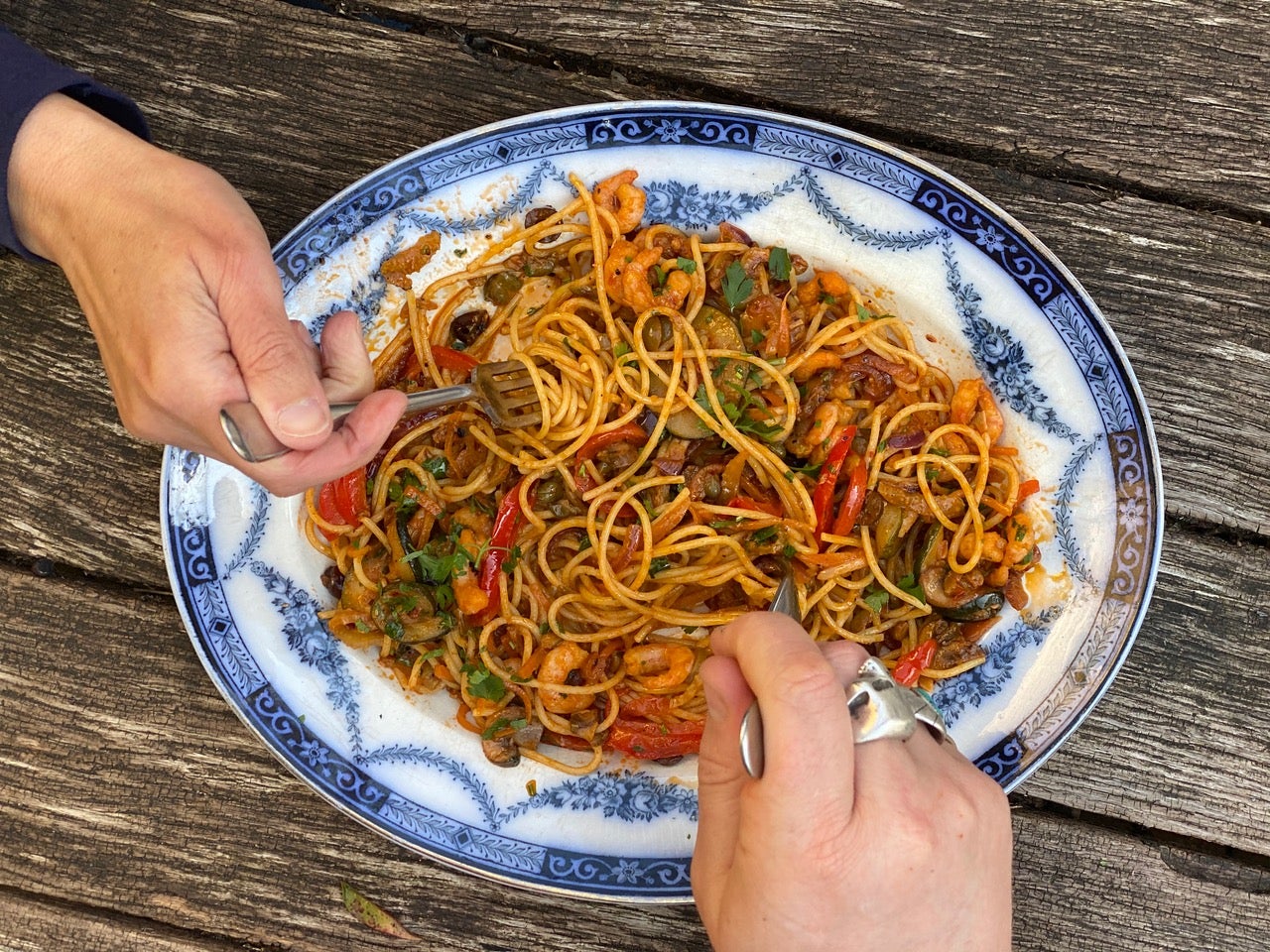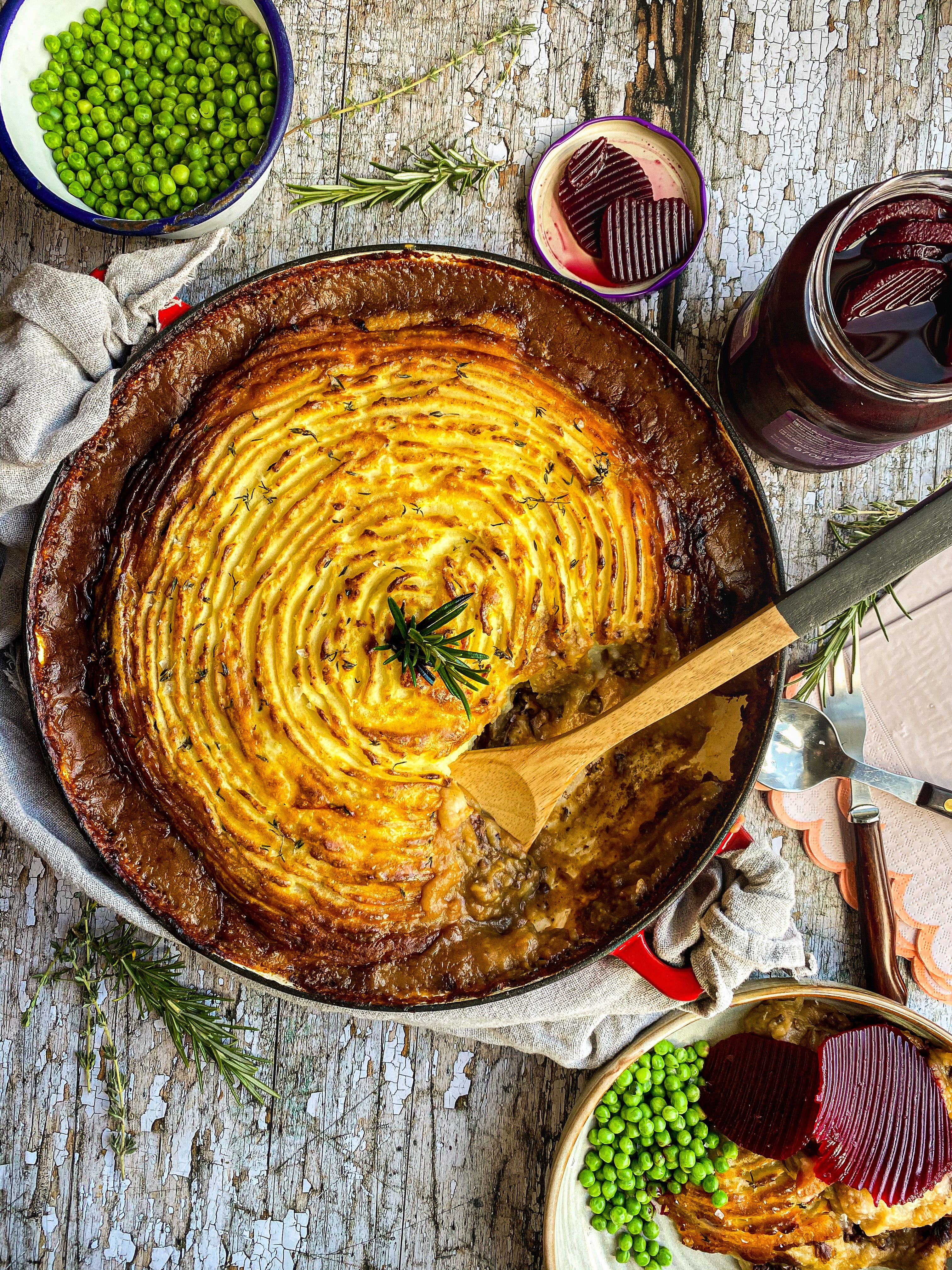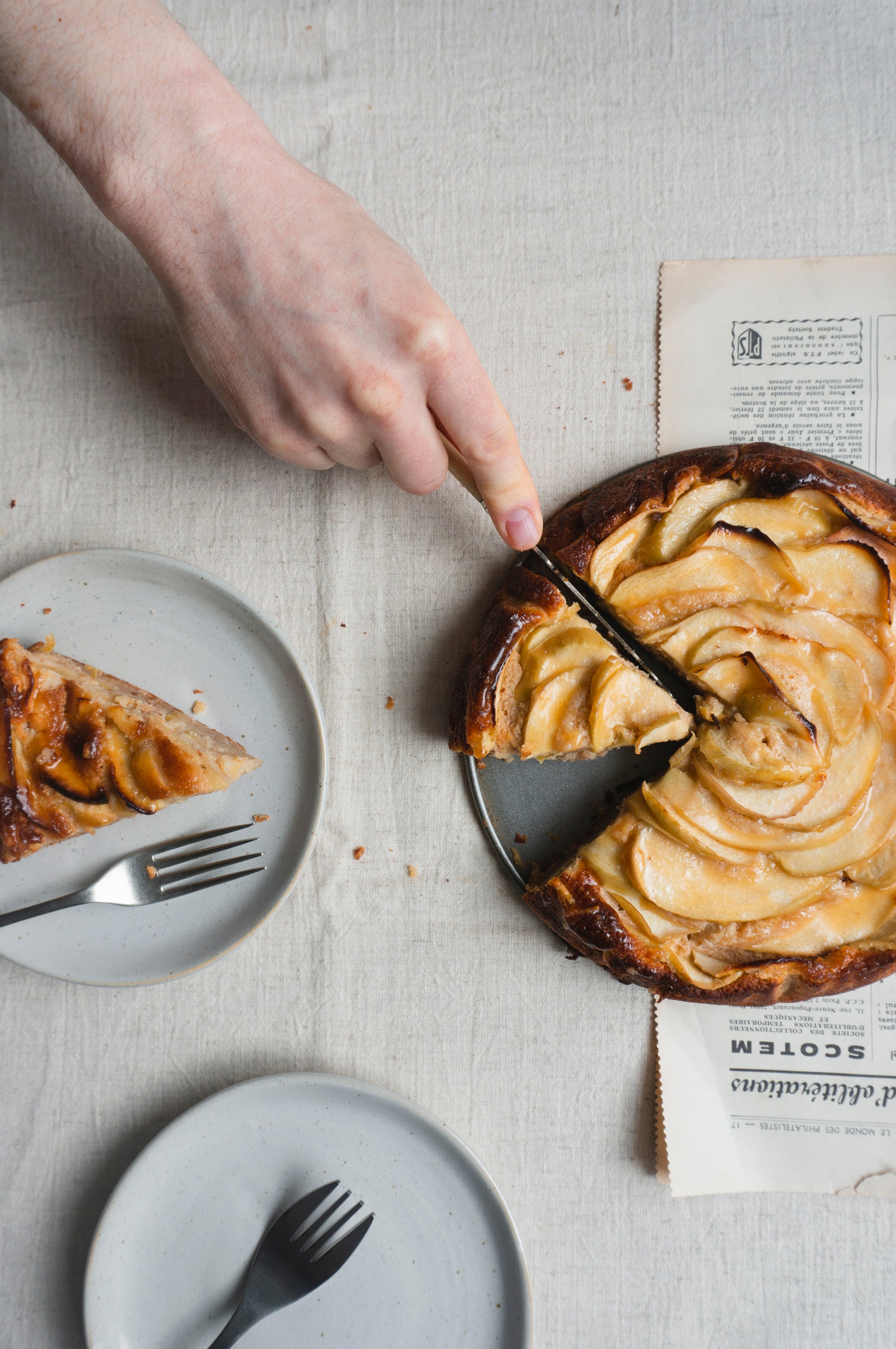Food Fighters: 4 recipes from the cookbook fighting food poverty
If you’re just as outraged at the free school meals debate as the Food Fighters, you should donate to their charity cookbook, says Hannah Twiggs. Here’s four recipes to show you why


Outraged by the votes in government last year to stop hungry children getting access to food during lockdown, Gemma Combellack and Becky Tanner-Rolf launched The Food Fighters, a charity project to fight food poverty in the UK.
In a call to arms on social media, the duo asked fellow food bloggers, chefs, designers, writers – and anyone else who shared their disgust about the free school meals “debate” – to answer the question: what recipe most feels like home to you?
Over 60 award-winning chefs, celebs, professional food writers and passionate cooks opened up their kitchens, and themselves, to share their treasured dishes in an interactive cookbook: The Food Fighters: Celebrating the Power of Food. All proceeds will go to Bankuet, a zero-waste food donation platform dedicated to making sure food banks across the UK are stocked with the products people need the most.
Simple, delicious and easy to follow recipes to make for yourself and your family (whether they’re your relatives or your housemates) are made even better by scalable servings, shoppable ingredients and a cook-along mode. The future of recipe books? We think so.
You can pre-order your copy of the eCookbook here or at the link at the end of this piece, but for now here’s a mouth-watering taste of what you can expect.
Pav bhaji
Over 10 years ago, I moved from Mumbai to Edinburgh before settling in Shetland. After all that time, and all that cooking, there’s only one dish that brings back instant memories of the street food back home: pav bhaji. It’s a spicy mashed vegetable dish (which is a cheap and easy one-pot meal to cook) accompanied by warm buttery pan-toasted rolls.
Pav bhaji is an iconic dish from Mumbai and hugely popular all over India. Originally, it was a quick lunch option for textile mill workers but gradually the dish became so popular that now it’s served as street food as well as in restaurants all over the country.
It’s best served piping hot with a dollop of butter, diced red onions, coriander and a squeeze of lime on top. I hope this dish brings you the same joy it does to me. Enjoy!
Recipe by: Akshay Borges, AKA @shetlandchef
Photography: Khaula Smart
Makes: 4 servings
Ingredients
2 tbsp oil
200g white onion, sliced
25g garlic, finely chopped
25g ginger, finely chopped
Spices:
2 tsp pav bhaji masala or 2 tsp garam masala
½ tsp cumin
½ tsp coriander
¼ tsp chilli turmeric
-
80g butter
250g tinned tomatoes or good quality tomatoes
800g potato, pre-boiled and diced
70g broccoli, cut into small florets
150g cauliflower, cut into small florets
1 bell pepper, sliced
400ml water
1 tsp salt
½ tsp caster sugar
100g peas
20g coriander, chopped
Garnish:
Coriander, chopped
Red onion, diced
Knob of butter
Squeeze of lime/lemon juice
To serve:
Bread rolls or sliced bread, toasted with butter
Method
1. In a pot on medium heat add the oil, white onion, ginger, garlic and the spices and cook for 12-15 minutes or until the onions turn translucent.
2. Add the butter and the tomatoes and cook for another 10 minutes .
3. Turn the heat to low and add your potatoes and mash it into the tomato spice mix.
4. Add the water, vegetables, salt and sugar. Mix and cover with a lid and cook for around 15 minutes, occasionally stirring so that it does not stick to the bottom of the pot.
5. Add the peas and the coriander at the end.
6. Garnish and serve with preferred bread roll
Read more:
Vegetable and seafood pasta

Kerry Godliman does a routine about being an exasperated mother, shopping at the supermarket with children who claim that they prefer one pasta shape to another. It’s such an accurate observation and hilariously performed. Look for it online. While I empathise with her plight (my adult kids still claim to prefer bows to shells), I’ve got to admit that I do prefer one pasta shape to the others. Spaghetti is the best and that’s that.
This recipe has been a favourite over the years and ideal for busy times. The vegetables used are interchangeable and a great way of using up those which are starting to go a bit dry (mushrooms), floppy (carrots and celery, I’m talking about you) or baggy (yeah peppers, you at the back!). Everything else either comes out of a jar, tin, tube or packet. Or the freezer.
Recipe and photography by: George Egg
Ingredients
5 tbsp extra virgin olive oil (plus more for dressing)
1 small red onion, sliced
2 garlic cloves, thinly sliced
½ carrot, sliced into thin matchsticks
1 red, yellow or orange pepper, sliced
1 celery stick, thinly sliced
1 small courgette, thinly sliced
4 or 5 button mushrooms, sliced
1 red chilli, sliced (or big pinch crushed chilli flakes)
Handful black and green olives, sliced
2 tbsp capers
4 anchovy fillets, roughly chopped
1 tbsp tomato puree
200g frozen prawns, mussels or a shellfish mix
Lots of black pepper
Lots of parsley
500g dried spaghetti
Half a lemon
Method
1. In a wide shallow pan warm up the olive oil and add the onion, garlic, carrot and pepper and cook over a low heat until they start to soften.
2. Now add the celery, courgette, mushroom, chilli, olives, capers and anchovies and continue to cook at a really low heat until everything is soft and starting to get to know each other for about 10-15 minutes.
3. Add the tomato puree and mix into the oily vegetables. You’ll probably need to add a splash of water every now and then to stop it catching but that’s OK. You want an oily jumble of veg, not a tomato sauce, so only a little. Go with your instinct.
4. Get a big pan of generously salted water on to boil (people rarely salt their pasta water enough – for a large pan of water I’d add a couple of heaped tablespoons. Remember, most of it goes down the sink so don’t get anxious).
5. When the water is boiling add the spaghetti and give it a good stir for the first minute or so and again every now and then.
6. A few minutes before the spaghetti is ready (do make sure it’s nice and al dente) bring the sauce up to a higher heat, add the frozen seafood, stir to get it mixed in, put a lid on the pan and immediately turn the heat off. The residual heat will warm through the seafood without making it tough. Trust me!
7. Drain your pasta just before you think it’s done, because it’ll cook a bit more in its own steam, and add it to the pan with the sauce. Stir it all together with lots of black pepper and parsley and a big squeeze of lemon.
8. If everything’s gone to plan it’ll be coated in a lovely red spicy oil. Superb.
9. Pile it high in pasta bowls, tuck a napkin into your collar, or if it’s easier, take your top off to eat. You’ll thank me, or at least the person who does the washing will.
Shepherd’s pie

When I think of autumn and winter food, this is one of the dishes that springs to mind straight away, but when it’s this good, don’t wait for when the clocks go back. This is the perfect family dinner for any day of the year. What's not to love? Golden brown crispy mash with a beautiful lamb filling in a rich sauce… is there anything more comforting and warming than a good shepherd’s pie? It’s a true British classic.
Now we have all had a bad shepherd’s pie, most probably in school (must try harder). But when made with love, care and attention, it becomes a thing of beauty. And what makes this my ultimate shepherd’s pie is that I don’t only use lamb mince but I also add slow-cooked lamb shank, which takes it to another level. But please don’t feel you have to use lamb shank – you can just add extra lamb mince and it will still be an ultimate winner.
Recipe and photography by: Richard Rodriquez
Ingredients
For the lamb shank:
2 lamb shanks
1 red onion, skin on and roughly chopped
1 carrot, roughly chopped
1 stick of celery, roughly chopped
2 garlic cloves, skin on and lightly crushed
3 sprigs of fresh rosemary
3 springs of fresh thyme
350ml red wine
500ml lamb stock
For the filling:
500g minced lamb
2 carrots, diced
2 onions, diced
2 sprigs of fresh rosemary, roughly chopped
2 tbsp of tomato puree
2 tbsp of Worcestershire sauce
1 tbsp of plain flour
350ml red wine
350ml lamb stock
For the mash:
1kg potatoes
25g butter
50ml milk
Method
1. Place a large ovenproof deep dish over a high heat and get it hot. Add a splash of oil and fry the lamb shanks for around 7-10 minutes or until nice and golden on all sides. Then add the onions, carrots, celery, garlic, herbs and season. Pour in the red wine and reduce for a couple of minutes. Add the stock. You want enough to cover the lamb, so top up with water if needs be, and bring to a boil. Pop a lid on leaving a small gap and place on the middle shelf of a preheated oven set at 160C for 2-3 hrs until super tender and falling off the bone. Once done, leave to one side.
2. In another large ovenproof deep dish over a high heat add a splash of oil and fry the minced lamb for 10 minutes. You want to get it nice and golden, then remove and pop to one side.
3. In the same dish, add a little more oil then add the carrots, onions, rosemary and cook over a low heat for 15 minutes, giving it a stir every so often.
4. Return the mince and any juices back to the dish, add the tomato puree and cook out for a minute.
5. Next, add the Worcestershire sauce and the flour and give it all a good mix. Turn up the heat right up. Add the wine and reduce the heat by ¾. This should take around 5 minutes and you’ll see it get nice and thick.
6. Add the stock, bring to the boil then put a lid on. Lower the heat to the lowest setting and simmer for 1 hour, stirring occasionally.
7. While the meat cooks, make your mash. Peel your potatoes and chop into large chunks. Place into a pan of boiling water for around 15 minutes until cooked through and soft. Drain and place into a pan with the milk and butter and mash until smooth. Set aside.
8. Once the hour is up turn off the heat and allow to rest while you take the lamb shanks and remove the meat off the bone then add to the dish. Give everything a good stir and check for seasoning. Top the filling with mash and pop into a preheated oven set at 200 C for 30 minutes or until golden brown. Serve with a mounting of peas and lots of beetroot or pickled red cabbage.
Nonna’s torta di mele

As an Italian, food plays an essential role in mine and my family’s life. There are recipes that have been passed on from my great-grandmothers all the way down to me. Flavours that have been running into our houses for years. One of those is my nonna’s torta di mele (apple pie).
A slice of this pie reminds me of Sundays. Of endless family lunches made of loud chatting and way too much food. Of cosy mornings where a slice of cake made everything better. Of childhood memories and our nonni’s stories told in front of the fire pit. A slice of this torta di mele reminds me of this and so much more.
I hope that this recipe will help make memories, and make you feel a part of my loud and wonderful Italian family too!
Recipe by: Marta Fabiani
Photography: Alexis Ko
Makes: 8 servings (however it can be stored in an air-tight container for up to 3 days so can also serve a smaller family without having to cut down on ingredients)
You will need: 25cm diameter, 4cm tall cake tin (ideal, but could be done in anything you have)
Ingredients
4 apples
1 lemon⠀
2 eggs (separate yolks and whites)⠀
150g brown caster sugar⠀
150g butter or veggie spread (melted)⠀
250ml milk (at room temperature)
1 tsp cinnamon
150g flour⠀
7g dried yeast⠀
Method⠀
1. Wash and finely slice your apples (you can also peel them if you’d rather not have the skin but I like to keep them in for extra colour and fibres). Squeeze the lemon and pour the juice in a bowl with the apples so that they don’t go brown.
2. In a separate bowl, beat the egg yolks with the sugar until creamy.
3. Add 250ml of the milk at room temperature and the sugar then mix with half of the milk and the melted butter and mix again until it’s well incorporated!
4. Sift the flour, the cinnamon and the yeast into the wet mixture, making sure to keep mixing while you do it to avoid clumps (you might need an extra pair of hands for this one!). Once the flour and yeast have been added add the remaining milk and mix once more.
5. In a separate bowl, beat eggs white until fluffy (to give you an idea, they should look so firm you’d be comfortable in turning the bowl upside down without the white falling down). Once ready, carefully add to the mixture and mix slowly with a spoon.
6. Line your cake tin with baking paper and pour the mixture gently into it.
7. Now for the fun part! Add the apples you’d have previously sliced in whatever shape you’d like (my nonna and I always do circles starting from the inner centre or in little separate spirals so they look like roses but you can get creative!).
8. Sprinkle with sugar and put in the pre-heated oven at 180C for 30 mins or until golden.
These recipes and more feature in ‘The Food Fighters: Celebrating the power of food’, an interactive cookbook launching in May. All profits go to Bankuet, a zero-waste food donation platform tackling food poverty in the UK. Pre-order your copy here.
Join our commenting forum
Join thought-provoking conversations, follow other Independent readers and see their replies
Comments